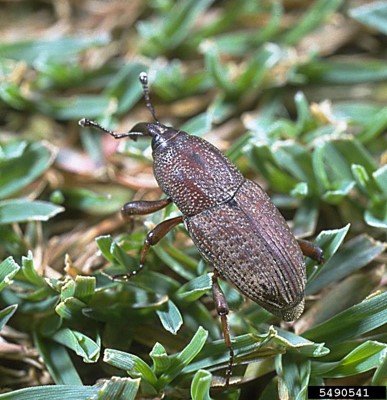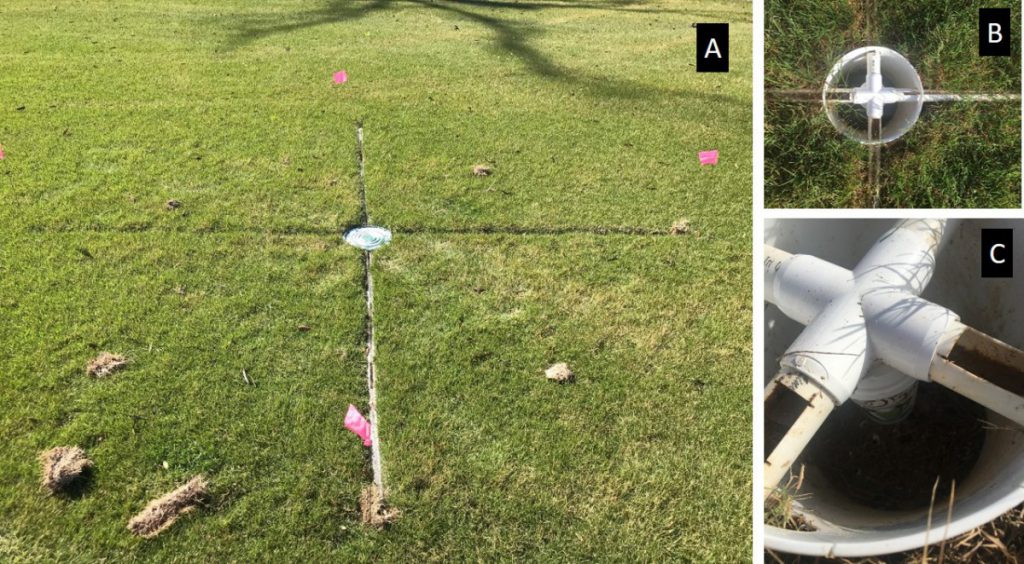Hunting billbug, Sphenophorous venatus vestitus (Family: Curculionidae) (Figure 1) is one of the important weevil pests of turfgrass in Georgia. It is called a billbug because of its long snout or “bill” which has small mandibles at the tip. Hunting billbug infestations in turfgrass are not easily detected until the first signs of feeding damage appear such as discoloration or irregular patches that appear scattered across the turfgrass. Although they attack all major turfgrass genotypes, damage on zoysiagrass cultivars can be particularly serious. In addition to hunting billbug, several other species of billbugs are found in warm-season turfgrass including lesser billbug, S. minimus and uneven billbug, S. inaequalis.

Damage
Hunting billbug damage to turfgrass is often misdiagnosed as damage caused by other factors such as white grub infestation, nutritional imbalance and drought. In certain zoysiagrass cultivars, impact of previous year billbug feeding damage is noticed in the following spring as the turfgrass struggles to emerge from winter dormancy. On established turfgrass, feeding damage first appears as yellowish brown or discolored patches (Figure 2), which do not improve with regular irrigation. The first instar larvae feed inside the stem, while later stages feed on the outside of the stem or stolon. This early stage larval damage on sod particularly interrupts machine harvest as the affected sod fails to hold together when cut.

Biology
Adult hunting billbugs mostly move around by crawling, rather than flying. They are active mostly at night, but can often be found on sidewalks and driveways in the early morning. Hunting billbugs are usually seen on actively growing thicker turfgrasses. The adult female of hunting billbugs will lay creamy-white, bean-shaped eggs. Eggs are singly inserted into feeding holes created by the adults on the turfgrass stems. The eggs hatch within 3-10 days depending on ambient air temperature. The emerged white, legless larvae feed within the stem. These patches of dead grass consist of hollow stems packed with sawdust-like frass that easily break apart when pulled. The young larvae develop inside the stem until fourth larval stage at which time they emerge from the plant and drop into the soil as their size increase. The last stage larvae feed on the root system. The first larval stage is about 1.33 mm in length whereas mature larvae are 6-10 mm length. The hunting billbug larvae (Figure 3) generally take 21-35 days to become pupae. Pupae are initially cream colored but they gradually change to a reddish brown color. They mostly overwinter as adults in protected areas, although larvae stages are also found in the winter months. Larval feeding causes most of the economic damage, although adult feeding can cause damage to grass blades. The adults emerge from overwintering sites on warmer days in spring. Two overlapping generations of hunting billbug per year have been reported from North Carolina whereas, six generations are reported from Florida.

Monitoring
One simple way of monitoring billbugs is by keeping record of any previous damage. The activity of adult hunting billbug can be monitored by regularly searching on mowed lawns and fairways at night using a flashlight. The larval activity can be monitored using the ‘tug test’ where the stems that have been under heavy infestation will break away easily when pulled. Pitfall traps can be used to monitor adults. A simple pitfall trap can be constructed using a plastic cup or container buried in the soil with the lip even with the soil surface. Crawling adults fall into the container and get trapped. A linear pitfall trap (Figure 4) can trap relatively more adults than a simple pitfall trap. This pitfall trap is constructed using PVC pipes by cutting a 1’ slit the length of the pipe and burying the pipe with the slit even with the soil surface. A cap is attached at one end and the other end leads into a plastic collection cup with a lid. The collection cup of this pitfall trap can be placed in a 2-gallon plastic pale or pot buried in the soil. Tiny holes can be created on the bottom of the 2-gallon plastic pale to drain rain water. One third of the collection container can be filled with ethylene glycol (antifreeze solution) as a killing and preservative agent. Similar to the simple pitfall trap, linear pitfall traps should be checked weekly to determine adult activity.

Management
As part of cultural control, some turfgrass types have a degree of resistance to billbug, although a complete control is rarely present. As part of integrated pest management, other turfgrass types and certain cultivars can be used to reduce billbug problems. Zoysiagrass cultivar that has been reported to provide a certain level of resistance to hunting billbug is ‘Zeon’. Endophyte infected ryegrass and fescues also show resistance to feeding billbugs. Nematodes that attack billbug larvae can be used as biological control. The commercially available nematodes, Steinernema carpocapsae, S. feltiae, and Heterorhabditis bacteriophora have all been reported to control billbug larvae. These nematodes are suited for use in organically managed areas and are available for residential, golf course and sod farm use for billbug control. The reliability of nematodes for billbug control is questionable because various factors such as number of live nematodes at the time of release and environmental conditions of the soil such as moisture levels and temperature can affect effectiveness. Please read the label instructions to determine how the use the product and shelve life.
Use of insecticides still remains the effective control option for billbugs. Insecticides such as neonicotinoids (imidacloprid or clothianidin) as well as diamides (chlorantraniliprole or cyantraniliprole) are effective against larval stages. The pyrethroid, bifenthrin is effective against adult billbugs.